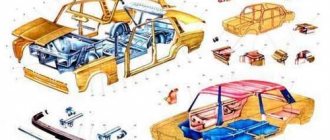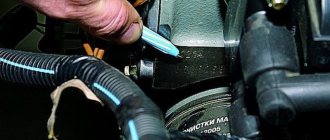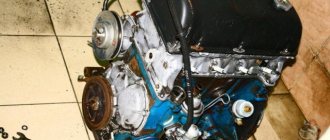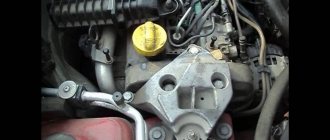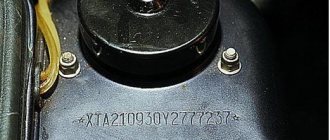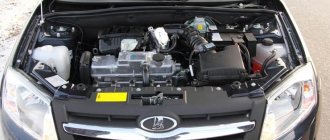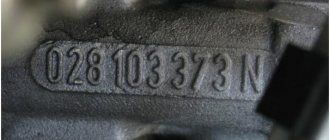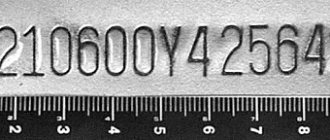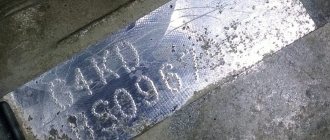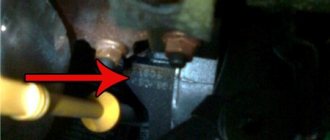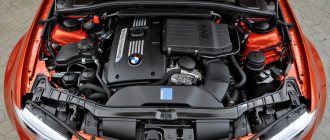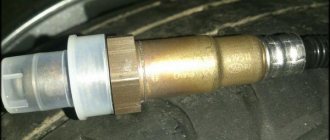Many owners are not concerned about this issue. These cars are quite cheap and it is unlikely that anyone will install a stolen engine, so no one checks the engine number when purchasing. There are no other cases for verification other than registering a car with the traffic police. And the traffic cops know where to look for him.
So where is the engine number on the VAZ 2109 and other front-wheel drive VAZ cars using the same engines? And the answer is simple - the number is located above the clutch housing.
Where is the engine number on the VAZ 2109
Where is the engine number on the VAZ 2109 and photo where is the engine number on the VAZ 2109 photo
If you open the hood and look at the engine, the number is stamped on the right side of the engine and is located just below the temperature sensor.
Where is the VAZ engine number where is the injector located?
Decoding of the identification number (XTA210930Y2696785):
the first three letters (XTA) – manufacturer’s index: 1 – geographical area (X – Europe); 2 – country (T – Russia); 3 – manufacturer (A – JSC “AVTOVAZ”);
the next six digits (210930) - car model;
letter of the Latin alphabet (Y) - code of the model year of the car (see table);
the last seven digits (2696785) are the body number.
Table 1. Vehicle model year code
| Code | Date of issue |
| A | 01.07.1979–30.06.1980 |
| B | 01.07.1980–30.06.1981 |
| C | 01.07.1981–30.06.1982 |
| D | 01.07.1982–30.06.1983 |
| E | 01.07.1983–30.06.1984 |
| F | 01.07.1984–30.06.1985 |
| G | 01.07.1985–30.06.1986 |
| H | 01.07.1986–30.06.1987 |
| J | 01.07.1987–30.06.1988 |
| K | 01.07.1988–30.06.1989 |
| L | 01.07.1989–30.06.1990 |
| M | 01.07.1990–30.06.1991 |
| N | 01.07.1991–30.06.1992 |
| P | 01.07.1992–30.06.1993 |
| R | 01.07.1993–30.06.1994 |
| S | 01.07.1994–30.06.1995 |
| T | 01.07.1995–30.06.1996 |
| V | 01.07.1996–30.06.1997 |
| W | 01.07.1997–30.06.1998 |
| X | 01.07.1998–30.06.1999 |
| Y | 01.07.1999–30.06.2000 |
| 1 | 01.07.2000–30.06.2001 |
| 2 | 01.07.2001–30.06.2002 |
| 3 | 01.07.2002–30.06.2003 |
| 4 | 01.07.2003–30.06.2004 |
| 5 | 01.07.2004–30.06.2005 |
| 6 | 01.07.2005–30.06.2006 |
| 7 | 01.07.2006–30.06.2007 |
| 8 | 01.07.2007–30.06.2008 |
| 9 | 01.07.2008–30.06.2009 |
| A | 01.07.2009–30.06.2010 |
Under the hood, on the partition of the engine compartment on the passenger side, there is an identification plate with the basic data of the car. | The body identification number is also stamped under the hood on the passenger side shock strut mount. | The engine model and number are stamped on the end of the cylinder block above the clutch housing. You can read the number using a mirror. |
Identification plate:
1 – manufacturer 2 – identification number 3 – engine model 4 – front axle load 5 – rear axle load 6 – execution option 7 – configuration option 8 – permissible maximum weight of the vehicle with trailer 9 – permissible maximum weight of the vehicle 10 – number to order spare parts
This is interesting: Where is the Cruze crankshaft sensor located?
Bumpers on the “nine”: repair and replacement
Often the rear and front bumpers on the “nine” are removed to repair them or to restore other parts of the body. You will still have to learn how to remove them correctly and without problems, no matter how you look at them, if the owner intends to carry out body repairs on his own.
Dismantling
So, in order to remove the rear bumper:
The front bumper is removed in the same way, only here you also need to remove the plastic fender liners.
Painting
The preferred color of bumpers on the “nine” is an eternal topic of discussion among fans of this car model. Many are on the side of the classic black color, although there are also those who believe that the color of the bumper should be in harmony with the color of the car.
Be that as it may, painting and decorative repairs are not difficult. The bumpers will need to be dismantled and thoroughly inspected for any deformations. If there are any, then you will have to straighten the elements and clean the remaining parts from old paint and rust.
Attention. If the bumper is plastic, then its defects can be repaired with putty.
Plastic bumpers can be easily removed from rust and paint using 200-400 grit sandpaper. If there are holes in the bumper, they can be closed with pieces of plastic removed from old bumpers or other plastic elements. As you know, plastic can be glued together well with a soldering iron with a power of 40-60 W.
In general, parts of a damaged plastic bumper can be fastened in 4 ways.
How to replace a car body
Main stages of technology
- To remove the 2109 body from the chassis, it is necessary to carry out a number of preparatory measures, in which case the car must be placed in a viewing hole and a winch (or some other lifting mechanism) must be prepared.
- Remove the hood, radiator grille, upper radiator trim panel along with the hood lock.
- Drain all liquid from the engine cooling system. Disconnect the hoses from the radiator pipes, unscrew the radiator fasteners and pull it out. Don't forget to disconnect the pipes from the interior heater tap.
- Drain the brake fluid from the brake system and clutch drive. In this case, the brake hoses screwed to the pipes going into the body must be disconnected.
- Disassemble the accelerator drive and parking brake. Disconnect the steering column shaft and the steering gear shaft; disconnect the electrical wires coming from the passenger compartment, and also remove the speedometer cable from the gearbox.
- The body and supporting system of the car are connected by bolts that need to be disconnected. The front bolts can be reached from the engine compartment. To gain access to the middle bolts, you will have to remove the plastic floor mat pads in the cabin (they are located behind the footrests). You can “get” the remaining bolts from the trunk (they are there under the floor plugs).
- Unscrew the bolts securing the floor hatch cover and remove it. In this case, the rubber seal must remain on the gearbox.
- Carefully lift the body using the lifting mechanism; must be hung from doorways (keep doors open).
- Assembly is carried out in reverse order.
At the car plant, the car body is manufactured without anti-corrosion treatment. Therefore, after replacement, it is better to immediately begin this process (while there is convenient access to all problem points).
Additional work
When the replacement of the body of a passenger car is completed, it is necessary to inspect and, if necessary, restore (replace) the remaining elements:
- Hood: when installing it, it is necessary to adjust the lock and hinges;
- Rear, front bumper (the rear is secured with a pair of nuts on each side, the front is screwed with side and front nuts);
- Radiator grille (attached with two screws that can be removed from under the hood, plus a central plastic latch);
- Front fenders: fastened with self-tapping screws using sealant (the fenders must be installed before installing the front bumper);
- Trunk door (lid);
- Side doors.
How the body of a VAZ 2101 is restored. You can learn more about auto tuning by reading our interesting article.
VAZ 2109 under the hood description
Location of the main components of the car
The power unit is located in the engine compartment under the hood; it occupies most of the engine compartment. The power unit is the engine along with the clutch, gearbox (clutch and gearbox are elements of the transmission) and the starter and generator installed on the engine.
The engine includes systems that enable it to operate. These include lubrication, cooling, power and exhaust systems. The operation of the injection engine is controlled by the ECM (electronic engine management system). In addition, the car has an engine starting system (starter, electrical circuits and switching devices) and a power supply system (generator and battery). The last two systems belong to the group of electrical equipment elements.
Engine compartment of a VAZ-2109 car with a carburetor engine
1 – windshield washer reservoir and tailgate glass; 2 – upper support of the rack; 3 – air filter housing; 4 – brake system hydraulic reservoir; 5 – expansion tank of the cooling system; 6 – battery; 7 – gearbox (not visible); 8 – engine.
Engine compartment of a VAZ-21099 car with an injection engine
1 – windshield washer reservoir; 2 – upper support of the rack; 3 – receiver; 4 – brake system hydraulic reservoir; 5 – expansion tank of the cooling system; 6 – battery; 7 – air filter housing; 8 – gearbox; 9 – engine.
Bottom view
The front of the car.
The levers, braces and anti-roll bar of the front suspension are clearly visible (like the front wheels, they belong to the group of chassis elements).
1 – front wheel suspension arm (chassis); 2 – lever extension (chassis); 3 – engine (sump pan with oil drain plug); 4 – gearbox; 5 – front wheel drive shaft (front wheel drives belong to the transmission); 6 – anti-roll bar (chassis); 7 – exhaust system (exhaust system).
The back of the car's underbody.
The beam is clearly visible, the shock absorbers and springs of the rear suspension are partially visible.
The main muffler of the exhaust system is located next to the wheel. At the rear of the car, behind the rear suspension beam, you can see a niche in the bottom of the trunk, which houses the spare wheel. 1 – shock absorber; 2 – rear suspension beam (chassis); 3 – fuel filter of the power supply system (only a car with an injection engine); 4 – main muffler of the exhaust gas system; 5 – niche in the bottom of the trunk for a spare wheel.
The bottom of the car under the driver and front passenger seats.
Under the bottom, parallel to the additional muffler pipe, there is a transmission control drive rod.
1 – additional exhaust system muffler; 2 – pipelines for hydraulic drive of the brake system and engine power supply system; 3 – drive rod for controlling the gearbox (transmission).
The bottom of the car under the seats of the rear passengers.
The fuel tank is located under the bottom, in front of the rear suspension beam.
Near the fuel tank, there is a pressure regulator that adjusts the brake fluid pressure in the brake mechanisms of the rear wheels. The pressure regulator belongs to the brake system. 1 – additional exhaust system muffler; 2 – fluid pressure regulator in the brake mechanisms of the rear wheels; 3 – fuel tank.
Hi all! Finally, I was able to devote some time to Nine. This time I decided to clean up the mess under the hood. I decided that for this I should start with the sink. Last year I washed it myself using two compounds (more details here www.drive2.ru/cars/lada/2...4062246863888394058/#post). And now I decided to entrust this matter to the professionals from the car wash. Bottom line
Of course, now it’s much better quality and cheaper (200 rubles, versus 300 rubles for two cans of cleaner). By the way, as a bonus, they treated the engine compartment with a special polymer composition that prevents dirt and dust from sticking to the treated parts. They said that next time the same cleanliness could be achieved by blowing out the engine with compressed air. Well, wait and see.
The next stage is soundproofing the hood (how nice it is to tinker under the hood clean!). The initial state:
Rice. 1–2. Engine compartment of VAZ-2109 (top view):
1 –
engine
2 –
washer reservoir
3 –
air filter
4 –
fuel pump
5 –
vacuum booster
Rice. 1–3. Engine compartment of VAZ-2109 (bottom view):
The need to verify the number
The arrow indicates where to look for the engine number
Whenever you buy a car, you need to check the engine number with what is on the documents. This applies to both registration and deregistration of the vehicle. Below, we will tell you where to find the engine number on a VAZ-2114 car.
The need to check the engine and body numbers, without exception, on any vehicle is primarily due to the fact that you do not purchase a stolen car.
Further, difficulties may arise if the engine is no longer original. It could have been changed, for example, removed from disassembly. And during verification, unnecessary problems will arise.
All numbers and letters indicated on the unit must completely coincide with those in the documents, excluding cases of correction . It is also necessary to pay attention to their integrity , that is, they should not have any mechanical damage.
Where can I look up the engine number on a VAZ-2114?
In total, there is one place on the car where the engine number is stamped - it is on the cylinder block on the right side, next to the thermostat, right above the clutch housing.
The engine number is clearly visible once you reach it.
The location of the number is indicated by an arrow.
Please note that in order to see it, you may need to dismantle the air filter housing, along with the pipes.
What year did the injection VAZ 2109 start?
The VAZ 2109 injection engine is not new. Since 1994, such units have been installed on cars of the Lada family. As you know, there have always been supporters and opponents of both carburetor and injection options. On the VAZ 2109, injection engine starting means less harmful emissions into the environment, better dynamics at high speeds and much more. From this publication you will learn not only the difference between both types of engine, but also receive valuable tips on how to change a carburetor unit to an injection unit with your own hands. So, both units have more than enough advantages. Before choosing which engine to choose for your “nine”, it is recommended to decide in what mode the car is operated most of the time. All this is of considerable importance.
Carburetor engine for VAZ 2109
VAZ 2109 injection engines
What can I say. Until now, many people respect this type of engine, despite its obsolescence. As you know, such engines are not installed on production cars today, but there are quite a few examples on the roads with a carburetor unit.
Note. Carburetor versions of engines have long received a scolding in developed countries. In Europe, where ecology and clean air are of great importance, such engines have long been blacklisted.
In principle, the large emission of harmful substances into the atmosphere is the first and most important disadvantage of such engines. Other features of this motor include the following:
- At high speeds, the “carburetor” significantly reduces its capabilities. We are talking about torque, which, however, is highest at low speeds.
Note. In particular, at high speeds it is more difficult for a VAZ 2109 with a carburetor power unit to overtake, due to the fact that the car’s throttle response is significantly reduced. On the other hand, when starting from a standstill, such an engine allows you to increase the required speed very quickly (14 or 16 s/100 km/h).
- High fuel consumption compared to an injector is another minus. As you know, the carburetor absorbs as much fuel as required. For example, under heavy loads it will require a lot of fuel (usual consumption is 8.7 l/100 km);
VAZ 2109 injection engine
- The presence of manual control of the air damper is a minus, but in the cold season it allows, as experienced motorists say, to “feel” the engine.
Note. Some VAZ 2109 models with a carburetor unit, released recently, even had automatic control of this damper.
Such an engine, of course, also has its advantages:
- First of all, the price of a carburetor is much cheaper;
- Its maintenance is also much easier and inexpensive;
- The absence of any control units on microcontrollers is considered by fans of carburetor VAZ 2109 as an advantage;
- An experienced driver can repair a carburetor anywhere, even in an open field, without special tools or an assistant.
Note. One of the options for quick carburetor repair involves purging, when two armored pipes are swapped. But with an injection engine this will definitely not be possible.
Carburetor. Advantages and disadvantages
Let's start with the negative points. These include:
- Such engines have not been installed on production cars for a long time. In Europe, due to environmental requirements, carburetors are blacklisted. That is, they are prohibited because they heavily pollute the atmosphere;
- At high speeds, the engine's capabilities drop significantly. Torque does not reach the desired levels. But at low speeds it is effective and allows you to accelerate well from zero to hundreds;
- When overtaking, the carburetor is a pain. It is problematic to overtake cars normally and confidently. Especially considering the power of the carburetor nines;
- High fuel consumption when compared with injection engines. On average, a nine with a carburetor in normal mode consumes about 8.5-9 liters of fuel per 100 kilometers;
- The air damper is controlled manually. The exception is some versions of the latest samples, where automatic devices have been installed. Some motorists claim that manually controlling the throttle in winter has its advantages, as it allows you to feel the engine. But only experienced drivers can understand this.
Nine carburetor
But let's not just talk about the bad. The VAZ 2109 with a carburetor also has positive qualities:
- The cost of a carburetor is much cheaper than an injection engine;
- Engine maintenance costs less, and the work itself is easier to perform if you repair it yourself;
- Fans of carburetors claim that the absence of control units and microcontrollers is an undeniable advantage. Although one can argue with him;
- If the engine fails even 100 kilometers from the nearest settlement or service station, it is not a problem for experienced drivers, since repairs can be carried out even in the field. But this will require the availability of appropriate tools and passenger assistance.
Swapping a couple of armored pipes and doing a purge is a simple option for quickly repairing a carburetor yourself. The injection engine does not understand such tricks.
Article on the topic: Features of replacing the rear brake cylinder 2114
Injector. Advantages and disadvantages
In short, all the advantages of the injector are the disadvantages of the carburetor, and all the disadvantages are the advantages of the carburetor.
Injection nine
The key features of injection engines include:
- Injectors are more environmentally friendly and meet the requirements for emissions of harmful substances;
- Although the torque is insufficient at low speeds, it makes overtaking easier at high speeds. The engine seems to get a second wind;
- Injector maintenance costs are higher;
- For normal operation of such an engine, clean fuel is needed. The carburetor “feeds” on everything;
- To check faults, it is necessary to perform diagnostics, which is time-consuming and expensive;
- The injector consumes less fuel. The average is 6-7 liters per 100 kilometers;
- Almost all systems function through computer control, therefore, when working correctly, the engine operates as efficiently and economically as possible;
- It is possible to install HBO on the injector. But with a carburetor, such a step is fraught with a number of difficulties.
Injector
VAZ 2109 with an injection engine
As in the case described above, there are advantages and disadvantages here. If I may say so, then all the advantages of the “carburetor” are the disadvantages of the injector and vice versa.
Peculiarities
- An injection engine has lower emissions of harmful substances and is more suitable to modern requirements than a carburetor engine;
- Torque is the opposite situation with the “carburetor”. Here at low speeds there is insufficient performance, but at high speed such a motor almost gets a second wind;
- Servicing the injector will cost a little more;
- The injector must be filled with clean fuel (otherwise the injectors will clog), while almost everything that gets into the carburetor flows into the carburetor;
- Malfunctions of the injector are shown by diagnostics, for which, again, you have to pay a tidy sum;
- The injector has lower fuel consumption, especially on the highway (6-7 l/100 km). This advantage is easy to explain: the injectors on such an engine are controlled by a computer that supplies a strictly measured amount of fuel.
Advice. The amount of fuel supplied depends on the ECU firmware. And if your VAZ 2109 with an injector consumes more fuel than normal, perhaps these are errors in the software.
- There is no need to use any “suction” or anything similar when servicing an injection engine. All unit speeds will be electronically regulated;
- Today, many owners install 4th generation gas equipment on cars. It is much easier to install such a kit on a VAZ 2109 than on the version with a carburetor.
Converting a carburetor to an injector
VAZ 21093 injection engines
This can be done. As promised, we provide instructions. The alteration can be carried out in your own garage, preferably with an assistant.
An object
The object of modification can be not only the VAZ 2109, but also the G8, as well as the VAZ 21099 (cars with carburetor engines). The goal and objective of the operation: to convert the unit into a 16-valve injector by installing a cylinder head from a VAZ 2112. Already at the stage of completing the conversion, without even adjusting the ECU, a big difference is felt. The dynamics of the car increases, the car behaves differently on the highway, and gas consumption decreases. On the other hand, the car's performance deteriorates at low speeds, but they are compensated by improved traction at high speeds (after 2000 rpm).
Note. Any owner of a “nine” will be glad that now his car will show the same acceleration in 4th speed as in the past in 3rd. If only the road is straight, then the “injector” will show itself and easily reach the level of 5000 rpm.
What is it needed for?
Knowing your license plate number may be required in the following cases:
- To identify the car, since the engine number is entered in the PTS. Without providing the number, the car will not be registered with the traffic police.
- To prevent fraud with the car, protection from fraudsters.
- Helps the owner to know the “cleanliness” of the car.
- The engine number helps to find out the real and honest power of the internal combustion engine (internal combustion engine), as well as the presence of various modifications and other technical information.
- It can help avoid problems with the traffic police if the car owner may need to re-register.
Featured Posts
sklifos
- Newbie
- Users
- 0
- 3 publications
- Car make:21093
- From: Togliatti
Good afternoon, please help me a week ago I bought a VAZ 21093 and I can’t find the engine number, tell me where it is? Thank you very much in advance!
TKO
- Newbie
- Users
- 0
- 47 publications
- Car make: 21093, 2115
- From:Ryazan
look under the thermostat, on the block.
sklifos
- Newbie
- Users
- 0
- 3 publications
- Car make:21093
- From: Togliatti
sklifos
- Newbie
- Users
- 0
- 3 publications
- Car make:21093
- From: Togliatti
I didn’t find it…..or it’s just hidden so well that you can’t see it….some numbers are there and some you can’t see..
PinceT
- Master
- VIP Member
- 39
- 1,413 publications
- Car make: mEtro
Perhaps splashed with dirt, or corroded!!!
Nikols
- User
- Users
- 0
- 75 publications
- Car make: VAZ 21099
- From:Moscow
I didn’t find it…..or it’s just hidden so well that you can’t see it….some numbers are there and some you can’t see..
He definitely should be there.
Sergey
- Zbugz
- VIP Member
- 1 533
- 26,706 publications
- Car make: Ford Kuga 2, Cherninkai
